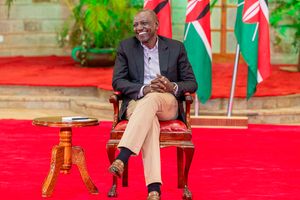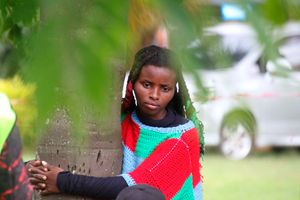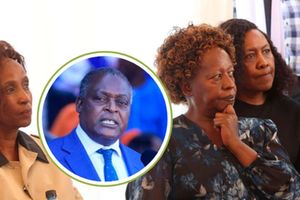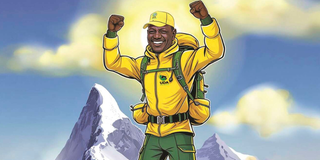
President Ruto’s tour was a crowning success which demolished assumptions that he had completely lost the massive Mt Kenya voting base.
President William Ruto’s strategists have every right to be extremely ecstatic with the outcome of his Mt Kenya tour. Enthusiastic crowds came out to listen and cheer as the presidential entourage traversed the region.
Fears that the foray, dubbed a development tour, would be met by indifference or outright hostility amid the now common ‘Ruto Must Go’ chants, proved unfounded as it proceeded with hardly any major incidents save for isolated heckling directed at some local MPs rather than the president himself.
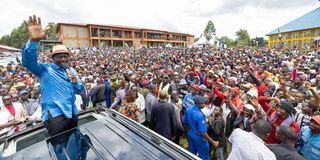
President William Ruto addressing Othaya Town residents on Saturday, April 5, 2025.
For President Ruto’s boosters, the tour was a crowning success which demolished assumptions that he had completely lost the massive Mt Kenya voting base after the impeachment of Deputy President Rigathi Gachagua last year.
The warm reception might call into question Gachagua’s claim that he now controls the region and will be the one to determine where it goes come the 2027 General Elections.
If the long-awaited tour of presumably hostile territory was a ‘King of the Mountain’ contest between the president and his ousted deputy, Ruto by the penultimate leg was a clear winner.
But that was just the first skirmish on the ground in what will be many more episodes to come.
Gachagua’s supporters might comfort themselves with the fact that cheering crowds are a very unreliable barometer of political leanings.
For one, they will say that they deliberately avoided confrontation by keeping well away from the tour, and not mobilising their supporters to counter it with jeering or parallel events.
Great impact
One thing which clearly had a great impact was the planning and resources poured into ensuring success of the tour. It was preceded by weeks of meetings involving MPs, governors and other local leaders, Cabinet secretaries, principal secretaries, parastatal chiefs and other senior civil servants from the region, as well as administrative and security chiefs all charged with ensuring massive turnouts and countering likely disruptions.
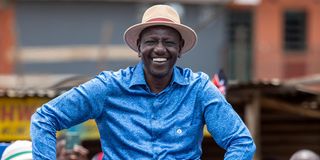
President William Ruto in Othaya, Nyeri, on April 5, 2025.
Gachagua watched afar as the tour proceeded, refraining from previous statements to the effect that Ruto would not be allowed to step into the Mt Kenya region.
His only comment on the eve of the tour was to encourage people to accept whatever money was on offer for attending the rallies and roadshows as it was their taxes coming back to them, an allusion to unverified stories doing the rounds that vast sums of money had been set aside for ‘rent- a-crowd’ schemes to ensure impressive turnouts.
Gachagua’s only other public comment was in dismissing Ruto’s claims in an interview with local broadcast stations on the eve of the tour that he had demanded Sh10 billion as the price for continued support leading up to the 2027 polls.
That Ruto fielded that interview and used it to level a number of damaging, but also unverified accusations against his former deputy serves as an indication of the importance he attached to the Mt Kenya tour. It is likely that he has not previously invested so much in time, planning and resources ahead of a tour to any other part of Kenya.
It was a contest for the heart and soul of Mt Kenya as well as do- or- die moment for Ruto’s need to demonstrate that he has not surrendered to his former deputy the populous region which supplied nearly 50 per cent of his 2022 presidential vote.
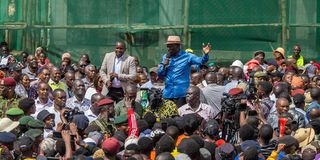
President William Ruto and Deputy President Kithure Kindiki address Nyeri town residents after inspecting affordable housing units on the final day of his Mt Kenya development tour on April 5, 2025.
Once Gachagua left the stable and presumably took away that massive vote, the general presumption has been that Ruto’s re-election prospects were almost fatally impacted.
His response was to cement a political deal with veteran opposition leader Raila Odinga, whose own impressive support base would hopefully counter the Mt Kenya exodus.
With that marriage sealed, Ruto was ready to write off Mt Kenya and build other alliances designed to isolate the region.
Some of the figures who came into the fold with Raila under the broad-based government arrangement aggressively pushed what resembled a replay of the 41-versus 1 strategy of the 2007 elections which sought to unite all the other ethnic groups in the country against the dominant Mt Kenya voting bloc.
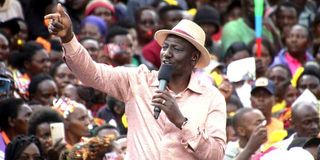
President William Ruto addresses residents of Runyenjes in Embu County on April 4, 2025 during his tour of Mt Kenya region.
Homa Bay MP Peter Kaluma has been the most outspoken in describing a Ruto-Raila alliance whose main motivation is to ensure the president's election by isolating and shutting out a Mt Kenya region that has received more than its fair share of the national cake. Some of Raila’s ODM entries in the Cabinet, including John Mbadi (Treasury), Opiyo Wandayi (Energy) and Ali Hassan Joho (Mining) have suggested diversion of development resources from the Mt Kenya region—which supposedly benefitted unproportionally from the regimes of Jomo Kenyatta, Mwai Kibaki and Uhuru Kenyatta—to Nyanza, Coast and other regions which were marginalised.
There were even calls for a radical shake-up of government, which would see presumed Gachagua allies from Mt Kenya ousted from the Cabinet and other senior positions and replaced with nominees from other regions that were supportive of the president.
2027 elections
Strategists around Ruto were resigned to the reality that the mountain vote was quickly dissipating, but he was not about to give up the region altogether, hence the premium attached to the Mt Kenya tour.
For one, they were suspicious of the virulent anti-Mt Kenya agenda pushed by Raila acolytes, which might have the effect of hastening the exodus, and therefore making Ruto completely hostage to the opposition chief heading to the 2027 elections.
Their calculations showed that even if the ground was clearly becoming very hostile, something could still be salvaged. That was the thinking, which informed the feelers sent out to former President Uhuru Kenyatta, who was invited to send in his nominees for inclusion in the cabinet.
Uhuru declined the overtures but did at least indicate that he would have no objection if Ruto identified his own nominees from the region. That was how Mutahi Kagwe (Agriculture), Lee Kinyanjui (Trade) and William Kabogo (ICT) made it to the Cabinet.
Raila also used the opportunity to get his own Mt Kenya allies into senior positions, notably Ndiritu Muriithi as chairman of the Kenya Revenue Authority, Mwangi wa Iria as chairman of the Public Procurement Regulatory Board and Peter Kenneth chairing the Kenya Bureau of Standards.
Ruto’s propaganda machinery aggressively pushed the narrative that those appointed were Uhuru nominees, but the only link was that they come from Mt Kenya though not his allies.
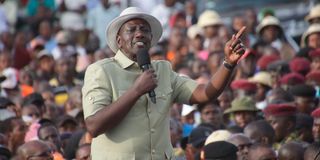
President William Ruto addresses residents at Kagio trading centre in Kirinyaga during his second day of Mt Kenya tour on April 2, 2025.
The idea was to dilute the Gachagua wave by creating impressions that Uhuru was also supporting the broad-based government arrangement. It was also intended to take advantage of the fact that Uhuru and Gachagua were not seeing eye-to-eye on the political direction of Mt Kenya.
Even with those appointments, however, the real test would be in Ruto making a triumphant entry to the mountain and demolishing perceptions that Gachagua was the man to beat.
That was achieved to some extent, with a reception which also demonstrated that unlike with Raila’s Nyanza support base, for instance, Mt Kenya voters are not firmly tied to any kingpin.
They did not follow outgoing President Kibaki’s direction at the 2013 elections, and completely rejected Uhuru’s campaign for Raila in 2022.
Approaching the 2027 polls, Gachagua could start to lose his grip if he does not demonstrate that he can lead his people to the Promised Land. Matters are complicated by the fact that unless his indictment as DP is overturned by the courts, he will remain disqualified from holding public office and cannot therefore be a candidate.
Gachagua is aware of this, and is also sensitive to the fact that propping up a surrogate from Mt Kenya will be unwise at a time when the rest of the country is clearly unhappy with a situation where the majority ethnic group dominates the presidency, three out of five presidents since independence, as well as the economic scene.
Uhuru is also aware of this fact, which was the justification for supporting Raila in 2022 instead of his estranged deputy Ruto, whose own Kalenjin community was moving to dominate State House occupancy in baton exchanges with Mt Kenya.
Gachagua, who keeps postponing the unveiling of his next political vehicle, has been sending signals Wiper Party leader Kalonzo Musyoka, the senior leader remaining in the opposition Azimio coalition after Raila’s departure, is his preferred candidate.
Also in the mix is DAP-K party leader Eugene Wamalwa, who was touted as Musyoka’s likely 2027 running mate. Uhuru’s faction of Jubilee Party fronted by Jeremiah Kioni, also remains in Azimio, but is thought to prefer throwing its weight, and presumably the Mt Kenya vote loyal to the former president, behind former Interior CS Fred Matiangi.
Also in the mix is Raila’s 2022 running-mate Martha Karua, whose attempt to inherit the Mt Kenya leadership vacuum under the Kamwene Movement and the Limuru III conference seems to have been stillborn. She quit Azimio once Raila started warming up to Ruto, but seems to be inching her way back into a united opposition fold where all eyes are on Gachagua’s next move.
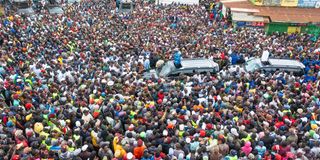
President William Ruto and Deputy President addressing Othaya Town residents on Saturday, April 5, 2025.
It works to Ruto’s advantage that, despite all the discontent evident with ‘Ruto Must Go’ chants, the opposition is still leaderless and rudderless. There is a growing list of potential presidential candidate raising their heads, including Busia Senator Okiya Omtata, former Chief Justice David Maraga and youth activist Morara Kebaso, but none of them have gained any traction or demonstrated potential control or backing of a significant voting bloc.
The ‘tribeless, partyless, leaderless’ Gen Z movement that provided a potent challenge to Ruto’s government with the youth revolt of last June seems to have frittered away, leaving the populous Mt Kenya vote as the most likely determining factor in the traditional equation of ethnic voting blocs.
But that is a bloc which as yet has no clear direction. Until Gachagua makes a definitive move and unless a towering and inspiring figure emerges, the mountain vote presently has no focus other than loose anti-Ruto sentiments.
The president from his campaign tour of the region will be taking home the likelihood that he can still win back some of the lost support.
He was on his tour escorted by a majority of MPs and governors from the region who have not joined the Gachagua bandwagon, with his team celebrating the return to his side Maragua MP Mary Wamaua, and the welcome accorded by Nyeri Governor Mutahi Kahiga, one of Gachagua’s most vocal supporters.
Ruto, however, has to contend with the fact that many of the leaders who joined his tour are not necessarily firmly in his fold, but hedging their bets and waiting for the opportune time to decamp.
Much was made of Kahiga’s presence on the tour, but the Nyeri governor was quick to assert that nothing much should be read into a county governor receiving the president in his domain.
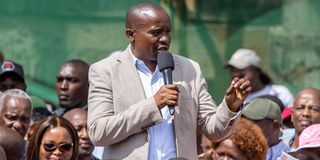
Deputy President Kithure Kindiki addresses Nyeri town residents on April 5, 2025.
There will clearly be a lot of shifts and turns in the coming weeks and months as Mt Kenya leaders asses their electoral prospects depending on whether they remain with Ruto, or decamp to whatever opposition grouping emerges to command the ground.
Keenly watched will be figures such as Kiharu MP Ndindi Nyoro, once a Ruto favourite often mentioned as a likely candidate for DP, who however, voted with his feet during the Gachagua impeachment by giving the National Assembly a wide berth.
Another figure worth looking at will be Murang’a Governor Irungu Kang’ata, a proven performer who gained fame for penning an open letter to President Uhuru at the tail end of the last government, explaining his decision to decamp to Ruto. The governor, not too long ago in his weekly newspaper column, delivered a cryptic message that could well have been interpreted as the first draft of another letter to come in due course.

